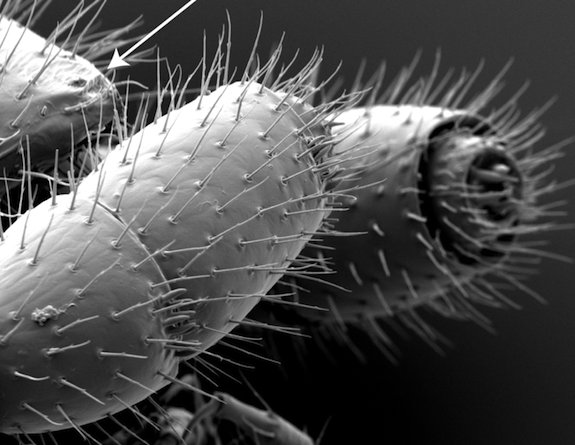Video: This 750-Leg Millipede is the Leggiest Creature in the World
Illacme plenipes, an extremely rare species endemic to just a few wooded areas in Northern California, is fully described for the first time
![]()
If, while watching this video, you thought of the classic arcade/cell phone/graphing calculator game Snake, you’re not the only one. This is a Illacme plenipes millipede, long thought extinct and rediscovered seven years ago. For an utterly unusual animal, one thing stands out: With up to 750 legs, it has more than any other creature found so far, including 9,999 other species of millipedes.

Illacme plenipes, the record-breaking millipede, only lives in a few woodlands in Northern California. Image via Marek et. al.
Yesterday, the first full description of the species was published in the joural ZooKeys. The study was led by Paul Marek of the University of Arizona. The millipede is known only from 17 live specimens Marek’s team found in a home range that is remarkably specific: three small wooded areas strewn with Arkose sandstone boulders in the foothills of San Benito County, California, near San Francisco.
The rareness of the millipede meant that from 1928 until 2005—when Marek, then a Ph.D. student, found a few specimens in the woods near San Juan Bautista—most scientists had simply assumed the species had gone extinct. Over the past seven years, Marek and his colleagues have taken several trips to the area, typically searching for hours before finding a single specimen clinging to the side of a boulder or tunneling four to six inches down into the ground.
In studying these specimens under a microscope, Marek has discovered a number of surprising characteristics that go beyond its legs. ”It basically looks like a thread,” Marek told LiveScience. “It has an uninteresting outward appearance, but when we looked at it with SEM and compound microscopes, we found a huge, amazingly complex anatomy.”
The new analysis revealed that the millipede has no eyes, disproportionately long antennae and a rudimentary fused mouth adapted for sucking and piercing plant structures. It also has specialized body hairs on its back that produce silk, which may be used as a defense mechanism to clear bacteria off the millipedes’ bodies.

A microscope image of the species’ specialized body hairs that produce a silk secretion. Image via Marek et. al.
Of course, the legs are the most striking part of the species’ anatomy. Despite the name millipede, no species are known to have 1,000 legs, but Illacme plenipes comes closest (its Latin name actually means “in highest fulfillment of feet”). The male specimens examined had at most 562 legs, but the females had more, with the winner at 750.
Most millipedes have somewhere between 80 and 100 legs. Marek and his colleagues speculate that this species’ extreme legginess could be a beneficial adaptation for subterranean tunneling or even for clinging to the boulders widely found in the species’ habitat.
DNA analysis has revealed that its closest cousin, Nematozonium filum, lives in Africa, with the two species’ ancestors apparently splitting apart sometime soon after the breakup of Pangea, more than 200 million years ago.
The team has tried to grow the millipedes in a lab but has so far been unable to. They caution that the species could be extremely endangered—in 2007, they stopped searching for wild specimens out of fears that they were depleting the population—and advocate for a formal protection listing, so scientists will have the time to learn more about them before the millipedes go extinct.
/https://tf-cmsv2-smithsonianmag-media.s3.amazonaws.com/accounts/headshot/joseph-stromberg-240.jpg)

/https://tf-cmsv2-smithsonianmag-media.s3.amazonaws.com/accounts/headshot/joseph-stromberg-240.jpg)